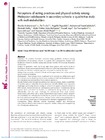| dc.contributor.author | Mohammadi, Shooka | |
| dc.contributor.author | Su, Tin Tin | |
| dc.contributor.author | Papadaki, Angeliki | |
| dc.contributor.author | Jalaludin, Muhammad Yazid | |
| dc.contributor.author | Dahlui, Maznah | |
| dc.contributor.author | Mohamed, Mohd Nahar Azmi | |
| dc.contributor.author | Jago, Russell | |
| dc.contributor.author | Toumpakari, Zoi | |
| dc.contributor.author | Johnson, Laura | |
| dc.contributor.author | Majid, Hazreen Abdul | |
| dc.date.accessioned | 2024-01-09T11:18:24Z | |
| dc.date.available | 2024-01-09T11:18:24Z | |
| dc.date.issued | 2020-08-03 | |
| dc.identifier.citation | Mohammadi, S., Su, T. T., Papadaki, A., Jalaludin, M. Y., Dahlui, M., Mohamed, M. N. A., Jago, R., Toumpakari, Z., Johnson, L., & Majid, H. A. (2021). Perceptions of eating practices and physical activity among Malaysian adolescents in secondary schools: a qualitative study with multi-stakeholders. Public health nutrition, 24(8), 2273-2285. https://doi.org/10.1017/S1368980020002293 | en |
| dc.identifier.issn | 1368-9800 | |
| dc.identifier.uri | https://aecc.archive.knowledgearc.net/handle/123456789/228 | |
| dc.description | Available under License - Creative Commons Attribution: https://creativecommons.org/licenses/by-nc-nd/4.0/deed.en | en |
| dc.description.abstract | Objective: To conduct formative research using qualitative methods among stakeholders of secondary schools to explore their perceptions, barriers and facilitators related to healthy eating and physical activity (PA) among Malaysian adolescents.
Design: A qualitative study involving eight focus groups and twelve in-depth interviews. Focus groups and interviews were recorded and transcribed verbatim. An inductive thematic analysis approach was used to analyse the data.
Setting: Four secondary schools in Perak and Selangor states (two urban and two rural schools) in Malaysia.
Participants: Focus groups were conducted with seventy-six adolescents aged 13–14 years, and in-depth interviews were conducted with four headmasters, four PA education teachers and four food canteen operators.
Results: Stakeholders thought that adolescents’ misperceptions, limited availability of healthy options, unhealthy food preferences and affordability were important challenges preventing healthy eating at school. Low-quality physical education (PE) classes, limited adolescent participation and teachers’ commitment during lessons were perceived as barriers to adolescents being active at school. Affordability was the main challenge for adolescents from rural schools. Stakeholders perceived that a future school-based intervention should improve the availability and subsidies for healthy foods, provide health education/training for both adolescents and PE teachers, enhance active adolescent participation in PE and develop social support mechanisms to facilitate engagement with PA.
Conclusions: These findings provide important insights into developing school-based lifestyle interventions to improve healthy eating and strengthening PA of Malaysian adolescents. | en |
| dc.language.iso | en | en |
| dc.publisher | Public Health Nutrition | en |
| dc.subject | Diet | en |
| dc.subject | Physical activity | en |
| dc.subject | School-based | en |
| dc.subject | Adolescents | en |
| dc.subject | Malaysia | en |
| dc.title | Perceptions of eating practices and physical activity among Malaysian adolescents in secondary schools: A qualitative study with multi-stakeholders | en |
| dc.type | Article | en |
| dc.identifier.doi | https://doi.org/10.1017/S1368980020002293 | |
